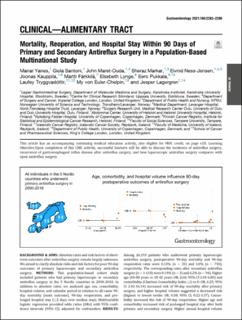| dc.description.abstract | Background & Aims
Absolute rates and risk factors of short-term outcomes after antireflux surgery remain largely unknown. We aimed to clarify absolute risks and risk factors for poor 90-day outcomes of primary laparoscopic and secondary antireflux surgery.
Methods
This population-based cohort study included patients who had primary laparoscopic or secondary antireflux surgery in the 5 Nordic countries in 2000-2018. In addition to absolute rates, we analyzed age, sex, comorbidity, hospital volume, and calendar period in relation to all-cause 90-day mortality (main outcome), 90-day reoperation, and prolonged hospital stay (≥2 days over median stay). Multivariable logistic regression provided odds ratios (ORs) with 95% confidence intervals (95% CI), adjusted for confounders.
Results
Among 26,193 patients who underwent primary laparoscopic antireflux surgery, postoperative 90-day mortality and 90-day reoperation rates were 0.13% (n = 35) and 3.0% (n = 750), respectively. The corresponding rates after secondary antireflux surgery (n = 1 618) were 0.19% (n = 3) and 6.2% (n = 94). Higher age (56-80 years vs 18-42 years: OR, 2.66; 95% CI 1.03-6.85) and comorbidity (Charlson Comorbidity Index ≥2 vs 0: OR, 6.25; 95% CI 2.42-16.14) increased risk of 90-day mortality after primary surgery, and higher hospital volume suggested a decreased risk (highest vs lowest tertile: OR, 0.58; 95% CI, 0.22-1.57). Comorbidity increased the risk of 90-day reoperation. Higher age and comorbidity increased risk of prolonged hospital stay after both primary and secondary surgery. Higher annual hospital volume decreased the risk of prolonged hospital stay after primary surgery (highest vs lowest tertile: OR, 0.74; 95% CI, 0.67-0.80).
Conclusion
These findings suggest that laparoscopic antireflux surgery has an overall favorable safety profile in the treatment of gastroesophageal reflux disease, particularly in younger patients without severe comorbidity who undergo surgery at high-volume centers. | en_US |

